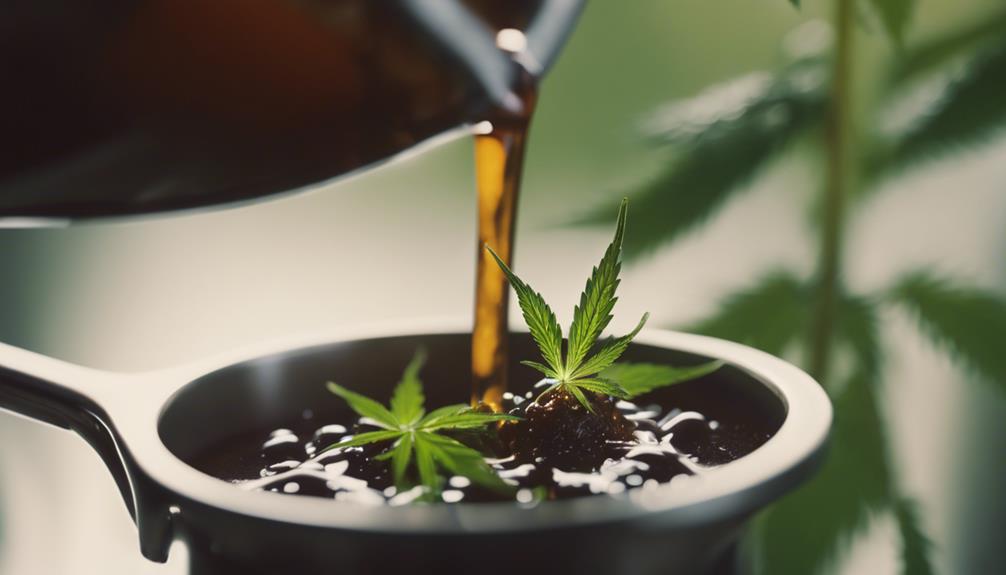In natural habitats, cannabis thrives in warm climates with specific soil pH levels, growing wild in Central and Southern Asia, tropical areas, and even mountainous regions. The plant showcases adaptability and resilience, persisting despite eradication efforts. Some wild cannabis plants can reach over 8 feet tall, highlighting their robust nature. Understanding these natural environments where cannabis grows can offer insights into the plant's genetic diversity and survival strategies.
Key Takeaways
- Cannabis grows naturally in warm, humid climates of Central and Southern Asia.
- It thrives in environments with soil pH levels between 5 and 7.
- Wild cannabis plants can be found globally, even in national parks and the U.S. Midwest.
- Adaptability to diverse environments is a characteristic of cannabis.
- Altitude, sunlight, water, and soil type are crucial factors for cannabis growth.
Natural Habitats of Cannabis
In observing the natural habitats of cannabis, it becomes evident that the plant thrives in warm and humid climates, primarily in central and southern Asia. Cannabis, also known as marijuana, is a wild weed that shows remarkable adaptability to different environments within this region.
These plants require specific soil nutrients, with pH levels ranging between 5 and 7, to flourish. Cannabis sativa X indica, the two primary strains, exhibit the ability to flower with at least 12 hours of light, showcasing their resilience and versatility.
Despite eradication efforts, wild cannabis plants, some towering over 8 feet tall, continue to thrive in locations where they've successfully adapted to the conditions, demonstrating the plant's robust nature in its natural habitat.
Geographic Distribution of Cannabis
Cannabis' geographic distribution reveals a fascinating pattern of adaptation to diverse environments worldwide. The plant, known as hemp or weed, can be found naturally in regions like Central and Southern Asia, its place of origin. It thrives in warm, humid climates with a soil pH level ranging between 5 and 7. Cannabis shows a particular affinity for areas with ample light, such as tropical environments and mountainous regions.
Surprisingly, wild cannabis plants have been documented globally, even appearing in unexpected locations like national parks and the U.S. Midwest. Throughout history, there have been references to the prevalence of wild cannabis, showcasing its ability to adapt and grow in various climates and terrains across the world.
Indigenous Marijuana Strains
Among the diverse array of indigenous marijuana strains, certain varieties like Lambs Bread and Nepalese landrace stand out for their unique genetic makeup and natural adaptability to their native environments.
- Indigenous strains, such as Lambs Bread, have specific genetic traits that contribute to their uplifting effects.
- Nepalese landrace strains, originating from the Himalayan mountains, possess adaptability to harsh mountain climates.
- Conservation efforts focusing on the natural habitats of these strains are essential for maintaining genetic diversity and preserving their unique properties.
Understanding and protecting these indigenous strains not only guarantees their survival but also opens avenues for further breeding efforts to enhance their beneficial genetic traits.
Environmental Factors for Cannabis Growth
Altitude and topography intricately shape the environmental conditions essential for the successful growth of cannabis plants. Factors such as sunlight exposure, water availability, and soil type are vital for best growth. During World War II, industrial hemp plants were cultivated for various uses, contributing to the spread of feral cannabis, also known as ditch weed.
Understanding these environmental factors is key to preserving strain characteristics and ensuring healthy cultivation. Best soil types like potting, living, and loamy soils support cannabis growth most effectively. Climate conditions with temperatures between 68 to 77 degrees Fahrenheit are ideal.
Challenges in Preserving Cannabis Biodiversity
Human activities, including human intervention, habitat destruction, and pesticide use, present significant challenges to the preservation of cannabis biodiversity. The following are key points to keep in mind in the conservation of cannabis plants:
- Indigenous Strains: Varieties like Lambs Bread and Nepalese landrace contain unique genetic traits important for the resilience and adaptability of marijuana (Cannabis sativa).
- Conservation Efforts: Initiatives must be implemented to protect these indigenous strains from extinction, especially in the face of environmental changes caused by factors like climate change and deforestation.
- Biodiversity Importance: Safeguarding the biodiversity of cannabis is vital for ensuring the sustainability and evolution of marijuana for various uses, including medicinal and recreational purposes. War and other conflicts can also threaten the existence of these valuable genetic resources.
Historical Background of Wild Cannabis
Wild cannabis, with its unique genetic characteristics and natural habitat preferences, has a rich historical background that offers insights into the evolution of this plant species.
Historical records trace back the use of wild marijuana to ancient civilizations like that of Chinese Emperor Shen Nung, who documented its medicinal properties around 2737 BCE.
These wild cannabis plants primarily belong to the indica variety, known for their bushier appearance and preference for warmer climates.
The female plant, particularly abundant in wild weed habitats such as the tropics, Himalayas, Mexico, and Jamaica, plays a vital role in the plant's reproduction and propagation.
Understanding the historical roots of wild cannabis sheds light on its significance in various cultures and ecosystems.
Threats to Wild Marijuana Habitats
Threats loom over the natural habitats of wild marijuana, stemming from factors such as habitat loss, human intervention, and pesticide use. These risks endanger the biodiversity and survival of indigenous strains like Lambs Bread and Nepalese landrace.
The challenges posed by climate change and deforestation further exacerbate the vulnerability of wild marijuana populations. To address these threats effectively, conservation efforts are essential to protect the unique genetic traits of these plants for future generations.
Safeguarding wild marijuana habitats is important not only for the preservation of these valuable strains but also for maintaining the overall ecological balance in these natural ecosystems. By recognizing and mitigating the dangers posed by habitat loss, human activities, and chemical contaminants, we can work towards a healthier coexistence with these important plant species.
Conservation Efforts for Cannabis
Conservation efforts play a crucial role in safeguarding the genetic diversity of cannabis strains against threats like habitat loss and climate change. Human activities such as deforestation, urbanization, and agricultural practices can lead to the loss of indigenous strains, impacting overall biodiversity. Preserving marijuana strains like Lambs Bread and Nepalese landrace is essential as they possess unique genetic traits that may be valuable for future medicinal and recreational purposes. By protecting biodiversity, we ensure the continued evolution and benefits of cannabis. Increased awareness of these threats and active participation in conservation initiatives are vital for maintaining the genetic diversity of marijuana and securing its sustainable future.
| Conservation Efforts | Marijuana Strains | Habitat Loss | Climate Change |
|---|---|---|---|
| Genetic Preservation | Lambs Bread | Deforestation | Temperature Shifts |
| Awareness Campaigns | Nepalese Landrace | Urbanization | Extreme Weather |
| Habitat Restoration | Hybrid Varieties | Agricultural Impacts | Precipitation Changes |
Frequently Asked Questions
Does Cannabis Grow Naturally in the Wild?
Yes, cannabis grows naturally in the wild. Wild cannabis habitats are diverse, thriving in various indigenous regions. These untamed locations offer unique organic cultivation environments, yielding landrace strains with distinct characteristics and lower THC levels.
Where Is Most Cannabis Grown?
Most cannabis is grown in indoor facilities, utilizing hydroponic methods and greenhouse production. Outdoor farming is also common, with soil requirements varying. Climate conditions and growing season restrictions play an essential role in cultivation.
Where Is Feral Cannabis Found?
Feral cannabis origins are diverse, with natural habitats spanning various regions globally. Wild cannabis populations exhibit indigenous growth, thriving in unattended cultivation. Their spontaneous growth and uninhibited proliferation showcase adaptability to different climates and terrains.
Can Cannabis Grow in the Woods?
Yes, cannabis can grow in forest environments. Wild habitats provide ideal conditions for the plant's growth. Woodland settings support diverse plant species. Natural ecosystems foster outdoor cultivation. The botanical origins of cannabis thrive in such environments.
Conclusion
To sum up, the natural habitats of cannabis are diverse and can be found in various regions around the world. The geographic distribution of cannabis includes both temperate and tropical climates, with indigenous marijuana strains adapting to their specific environments.
Environmental factors play a vital role in the growth of cannabis, but challenges in preserving biodiversity and threats to wild habitats continue to pose significant risks. Conservation efforts are essential to safeguard the future of cannabis diversity.




